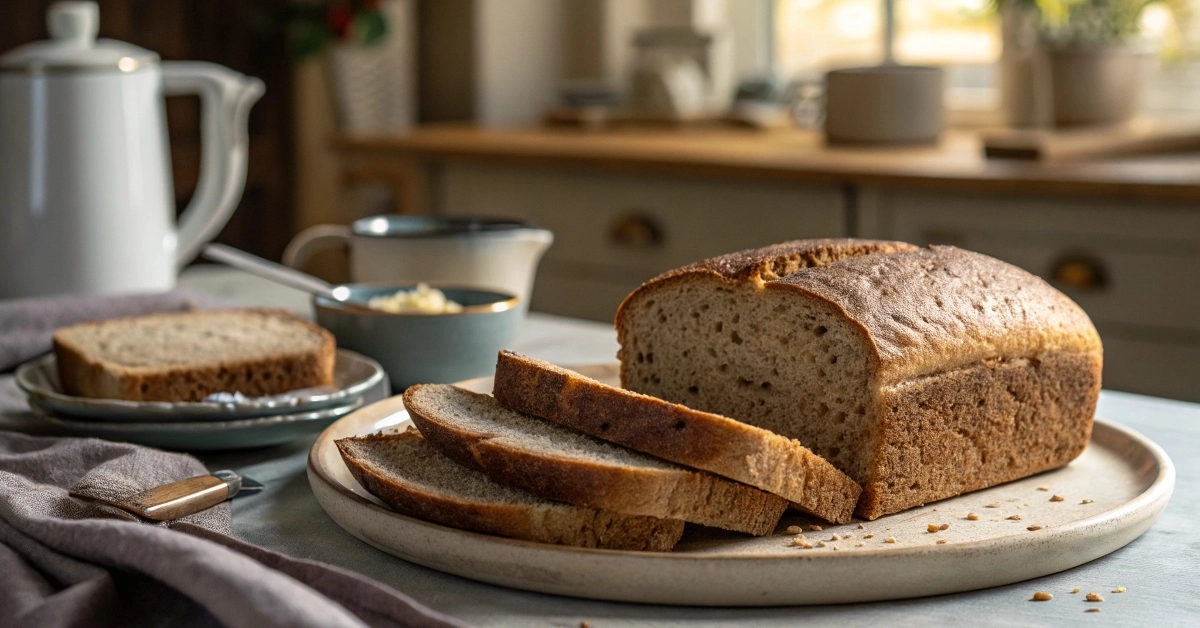Introduction
Buckwheat bread is more than just a gluten-free trend—it’s a nutritious, hearty, and satisfying alternative to traditional wheat-based loaves. Despite the misleading name, buckwheat isn’t related to wheat at all. It’s a seed loaded with essential nutrients, naturally gluten-free, and incredibly versatile in the kitchen. Whether you’re managing gluten intolerance, looking for healthier carbs, or just exploring new textures in your homemade bread, buckwheat deserves your attention.
In this guide, we’ll cover everything you need to know—from its health benefits and baking tips to how it compares with wheat and other bread types. You’ll also get answers to the most Googled questions like Is buckwheat anti-inflammatory? and Can I use buckwheat flour instead of all-purpose flour?
Looking for inspiration? Try our best buttermilk recipes to pair with homemade buckwheat bread.
What is Buckwheat Bread?
Understanding Buckwheat as a Grain Alternative
Buckwheat isn’t a grain in the traditional sense—it’s a pseudocereal. That means it behaves like a grain but comes from a seed, closely related to rhubarb and sorrel. It’s naturally gluten-free, rich in plant-based protein, fiber, and several key minerals like magnesium, copper, and manganese.
What makes buckwheat bread stand out is its earthy flavor, dense texture, and incredible nutritional profile. Unlike refined wheat breads that spike blood sugar levels, buckwheat offers a lower glycemic impact, making it a great option for people with diabetes, celiac disease, or those simply looking to eat cleaner.
Buckwheat flour is made by grinding whole buckwheat groats. It can be used on its own or mixed with other flours like almond, oat, or rice flour to improve softness and rise. Because it doesn’t contain gluten, buckwheat bread recipes often rely on binding agents like psyllium husk, eggs, or chia seeds to hold everything together.
The Origins and Rise of Buckwheat in Baking
Though trending now in health circles, buckwheat has been around for centuries. It’s been a staple in Eastern European and Asian diets for generations. Russian blini, Japanese soba noodles, and French galettes all use buckwheat flour in their base. Its re-emergence in modern gluten-free baking owes much to its impressive health properties and increasing demand for clean-label food.
In today’s home kitchens, buckwheat bread is finding its way into more ovens because it checks all the boxes—healthy, allergy-friendly, and easy to customize. Whether you bake it as a rustic loaf or use it for sandwich bread, it’s a nutrient-rich upgrade from white or even whole wheat bread.
Want to pair your slice with something naturally sweet? Discover great ideas like these sweet honey dessert recipes to balance out buckwheat’s nutty notes.
Nutritional Benefits of Buckwheat Bread
Key Vitamins, Minerals, and Fiber Content
Buckwheat bread shines when it comes to nutritional density. Unlike most refined wheat breads, buckwheat offers a balanced profile of complex carbs, plant-based protein, and essential minerals.
Here’s a breakdown of the nutritional highlights per 100g of buckwheat flour:
| Nutrient | Amount | Benefits |
|---|---|---|
| Protein | 13g | Supports muscle maintenance |
| Dietary Fiber | 10g | Aids digestion and gut health |
| Magnesium | 231mg | Regulates blood sugar, heart health |
| Manganese | 1.3mg | Antioxidant, bone formation |
| Copper | 1.1mg | Boosts immunity, supports nerves |
| Iron | 2.2mg | Improves oxygen transport |
| B-Vitamins (B1, B2, B3) | Moderate | Supports energy metabolism |
Compared to white bread or even whole wheat, buckwheat bread delivers more dietary fiber, micronutrients, and slow-digesting carbs. That means longer satiety, fewer sugar crashes, and better gut support.
It’s also naturally low in fat and completely free from cholesterol, which is a plus for heart-conscious eaters.
Why It’s a Smart Choice for Gut and Heart Health
Gut health starts with fiber—and buckwheat bread delivers plenty of it. That fiber feeds your beneficial gut bacteria, improving digestion, reducing inflammation, and helping regulate cholesterol.
In fact, buckwheat contains resistant starch, which works like a prebiotic. It travels through the digestive system undigested until it reaches the colon, where it ferments and promotes healthy bacterial growth. This supports immunity, weight balance, and even mental clarity.
From a heart-health perspective, buckwheat is rich in rutin, a plant compound known to strengthen blood vessels and reduce LDL cholesterol. Combined with magnesium, it helps relax blood vessels and stabilize blood pressure naturally.
That’s not all—buckwheat also contains plant lignans and polyphenols with anti-inflammatory effects, which can lower the risk of chronic illnesses like heart disease and type 2 diabetes.
Looking for more natural health recipes? Check out our natural mounjaro recipe for a metabolism-friendly drink you can enjoy with a fresh slice of buckwheat bread.
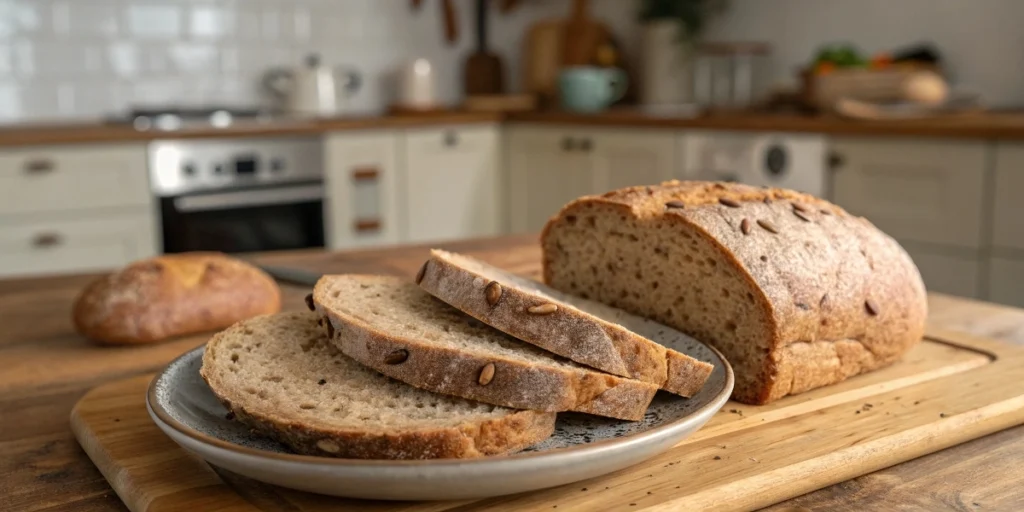
Is Buckwheat Bread Healthy?
Comparing Buckwheat Bread vs. Wheat Bread
When it comes to choosing the healthiest bread for your body, many people are torn between traditional wheat and gluten-free alternatives. So how does buckwheat bread measure up?
Let’s take a side-by-side look:
| Nutrient/Feature | Buckwheat Bread | Wheat Bread (Whole Grain) |
|---|---|---|
| Gluten Content | None | Contains gluten |
| Glycemic Index | Low (45–55) | Medium to High (65–75) |
| Protein Quality | High in lysine (complete) | Incomplete amino acid profile |
| Fiber Content | 8–10g per 100g | 6–8g per 100g |
| Common Additives | Usually minimal, homemade | Often contains preservatives |
| Digestibility | Easy on gut (especially GF) | Can trigger sensitivities |
Wheat bread, even whole grain, is often made with processed ingredients and refined flours unless specifically labeled 100% whole wheat. Buckwheat bread, on the other hand, especially when homemade, is typically made from clean, whole ingredients and naturally boasts more nutrients per bite.
Thanks to its high lysine content, buckwheat provides a complete protein, making it especially valuable for vegetarians and vegans. It also delivers a gentler effect on blood sugar, helping stabilize energy levels throughout the day.
Check out our homemade manjaro natural weight loss drink for a powerful pairing with your healthy buckwheat loaf.
Low Glycemic Index and Anti-Inflammatory Properties
One of the biggest advantages of buckwheat bread is its naturally low glycemic index. Unlike refined wheat products that can spike insulin levels, buckwheat digests slowly, keeping your blood sugar steady and reducing cravings.
Even more impressively, buckwheat contains flavonoids, including rutin and quercetin—plant compounds known for their anti-inflammatory and antioxidant properties. These help fight free radicals, reduce internal swelling, and support long-term health.
This makes buckwheat bread a strong ally for people with:
- Diabetes
- Celiac disease
- Inflammatory conditions like arthritis or IBS
- Cardiovascular risk factors
Its prebiotic fibers also reduce inflammation by supporting a healthy gut microbiome, which plays a crucial role in immunity and mood regulation.
Don’t miss our strawberry vanilla cake for a delicious, natural dessert option that pairs beautifully with buckwheat’s nutty flavor.
Baking with Buckwheat Flour
Can You Replace All-Purpose Flour with Buckwheat?
Absolutely—but with some caveats. Buckwheat flour is dense, earthy, and gluten-free, which means it behaves differently than all-purpose flour in baking. If you try to substitute it one-for-one in a traditional bread recipe, you might end up with a loaf that’s dry, crumbly, or too dense to rise properly.
Here’s the deal: while you can replace all-purpose flour with buckwheat flour, it’s often best to use a blend of flours to achieve the right structure and softness. Pairing buckwheat with ingredients like:
- Tapioca starch or arrowroot powder for softness
- Rice flour for a lighter texture
- Almond flour for a nutty, moist feel
- Psyllium husk or chia seeds for binding power
…can help you bake bread that’s both hearty and sliceable.
If you’re going 100% buckwheat, make sure to include enough moisture and binding agents, like eggs or flax eggs, and expect a denser loaf—more rustic, but super flavorful.
Here’s a quick cheat sheet:
| Ingredient | Role in Buckwheat Baking |
|---|---|
| Buckwheat flour | Base flour, rich in nutrients |
| Psyllium husk/chia | Replaces gluten, adds structure |
| Vinegar or lemon juice | Helps with rise and flavor balance |
| Baking soda/powder | Leavening, especially in quick breads |
| Coconut oil/olive oil | Adds moisture |
Looking for a healthy drink to pair with your baked loaf? Check out our natural mounjaro recipe—a perfect gut-friendly combo with your buckwheat creation.
Tips for Baking Soft, Moist Buckwheat Bread at Home
Baking with buckwheat doesn’t have to be complicated. With the right techniques, you can make soft, flavorful bread every time:
- Hydrate well: Buckwheat flour absorbs a lot of moisture. Let the batter or dough rest to fully hydrate before baking.
- Add acid: A splash of apple cider vinegar or lemon juice helps balance flavor and react with baking soda for rise.
- Don’t overmix: Especially when mixing buckwheat with other flours, gentle folding keeps the loaf light.
- Bake low and slow: Opt for a slightly lower temperature and longer baking time to prevent the crust from hardening before the inside is cooked.
- Use a lined loaf pan: Buckwheat can be sticky. Line your pan with parchment for easy removal and a smooth bottom.
These tips make buckwheat bread beginner-friendly and perfect for everyday baking—even if you’ve never baked without gluten before.
Don’t miss our guide to sweet honey dessert recipes—they’re great alongside a slice of warm buckwheat bread with a drizzle of natural sweetness.
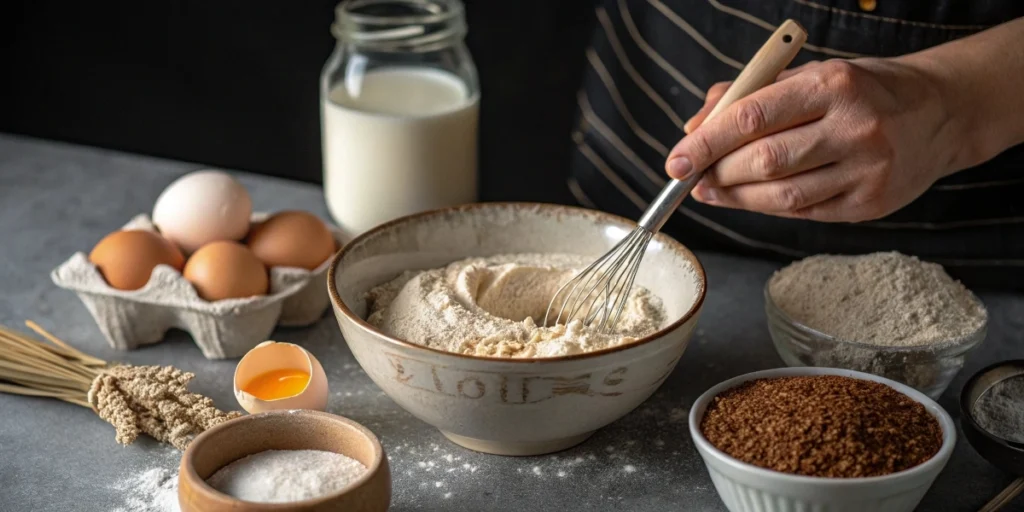
Different Types of Buckwheat Bread
Sourdough, Quick Breads, and Gluten-Free Loaves
Buckwheat bread is incredibly versatile. Whether you’re craving a chewy artisan-style loaf or a quick mix-and-bake option, there’s a style for every skill level and kitchen setup.
Here are the main types of buckwheat bread you can make:
1. Buckwheat Sourdough Bread
This version uses a naturally fermented starter, often gluten-free, to rise. The result? A tangy, hearty loaf that’s easier to digest thanks to the fermentation process. Sourdough enhances buckwheat’s earthy flavor and can stay fresh longer than yeast-based loaves.
Pro tip: Use a mix of buckwheat and brown rice flour in your starter to maintain a gluten-free base.
2. Quick Buckwheat Bread
Don’t want to deal with yeast or starters? No problem. Quick breads rely on baking soda and baking powder to rise. You can whip them up in a single bowl—just mix, pour, and bake. They’re ideal for busy mornings or when you need a fast, healthy option.
Popular add-ins:
- Bananas or applesauce for sweetness
- Carrots or zucchini for moisture
- Walnuts, raisins, or seeds for texture
3. Gluten-Free Yeast Loaf
For those who prefer a more traditional loaf structure, this one’s for you. Using yeast, warm water, and gluten-free binders like psyllium husk or xanthan gum, you can create sandwich-ready buckwheat bread with great rise and crumb.
It’s perfect for:
- Sandwiches
- Avocado toast
- Grilled cheese
Looking for a healthy twist on classic comfort food? Don’t miss our cottage cheese banana bread—another great example of wholesome, homemade baking.
How to Customize Your Buckwheat Bread with Seeds, Nuts, or Sweeteners
Once you’ve nailed the base recipe, customization is where the fun begins. Buckwheat’s bold flavor pairs well with both savory and sweet additions, making it perfect for a variety of dietary styles.
Savory Add-Ins:
- Sunflower, pumpkin, or flaxseeds for crunch
- Chopped herbs like rosemary or thyme
- Caramelized onions or garlic for depth
Sweet Add-Ins:
- Cinnamon, nutmeg, or cardamom
- Chopped dates, raisins, or cranberries
- Maple syrup or honey for natural sweetness
Pro tip: For a high-protein loaf, toss in hemp seeds, chopped almonds, or even cooked quinoa.
These variations not only enhance flavor and texture—they also boost nutrition. The best part? You stay in control of what goes into your bread, with no preservatives, no refined sugars, and no mystery ingredients.
Want to bake something indulgent too? Check out our cream cheese banana bread with cinnamon topping—a sweet treat with a cozy twist.
How to Make Buckwheat Bread at Home
Step-by-Step Buckwheat Bread Recipe
This easy buckwheat bread recipe is gluten-free, dairy-free, and doesn’t require yeast—making it ideal for anyone with dietary restrictions or limited ingredients on hand.
Here’s what you’ll need:
Ingredients:
| Ingredient | Quantity |
|---|---|
| Buckwheat flour | 2 cups |
| Baking soda | 1 tsp |
| Apple cider vinegar | 1 tbsp |
| Ground flaxseed (or chia) | 2 tbsp |
| Warm water | 1 ½ cups |
| Olive oil or coconut oil | 2 tbsp |
| Sea salt | ½ tsp |
| Optional: seeds, herbs, or dried fruit | ¼ cup |
Instructions:
- Preheat oven to 350°F (175°C) and line a loaf pan with parchment paper.
- In a small bowl, combine flaxseed and 6 tbsp warm water. Let sit for 5 minutes to gel.
- In a large bowl, mix the buckwheat flour, baking soda, and sea salt.
- Add in flaxseed mixture, apple cider vinegar, oil, and the rest of the warm water. Stir until a thick batter forms.
- Fold in any optional add-ins like sunflower seeds or raisins.
- Pour the mixture into the prepared pan and smooth the top.
- Bake for 50–60 minutes, or until a toothpick comes out clean.
- Let it cool in the pan for 10 minutes, then remove and place on a rack to cool fully.
Pro Tip: Letting it cool is crucial—cutting it too soon can cause a gummy texture. The crumb sets as it cools, becoming easy to slice and store.
Looking for a natural pairing? This loaf goes perfectly with our homemade manjaro natural weight loss drink, especially for a detox breakfast or midday energy boost.
Common Mistakes and How to Fix Them
Even seasoned bakers can run into issues with gluten-free bread. Here are the top mistakes—and how to avoid them.
1. Loaf is too dry or crumbly
Why it happens: Not enough moisture or no binding agent.
Fix: Add more liquid next time and include a binding ingredient like flax or psyllium husk.
2. Dense, heavy texture
Why it happens: Overmixing or using cold ingredients.
Fix: Mix gently and make sure water is warm—not hot—and all ingredients are at room temp.
3. Bitter or earthy aftertaste
Why it happens: Buckwheat flour is strong on its own.
Fix: Balance it with natural sweeteners (like maple syrup), or add cinnamon, herbs, or lemon zest.
4. Doesn’t rise
Why it happens: No gluten and no acid for the leavening agent.
Fix: Always include a combination of baking soda and apple cider vinegar to give it some lift.
Once you master this recipe, you can customize it into a savory loaf with garlic and herbs, or a sweet breakfast bread with cinnamon and dates.
Buckwheat Bread for Special Diets
Is Buckwheat Bread Vegan, Gluten-Free, or Keto-Friendly?
Buckwheat bread is a superstar in the world of specialty diets, especially for those avoiding gluten, dairy, or animal products.
Let’s break it down:
✅ Gluten-Free
Despite the “wheat” in its name, buckwheat is 100% gluten-free. It’s a seed, not a grain, which makes it ideal for anyone with celiac disease, gluten sensitivity, or autoimmune conditions. Just ensure you’re using certified gluten-free buckwheat flour to avoid cross-contamination during processing.
✅ Vegan
Buckwheat flour itself is completely plant-based. As long as you’re not adding dairy, eggs, or animal-derived ingredients (like honey if you’re a strict vegan), your buckwheat bread is fully vegan. Use flaxseed or chia eggs as binders, and plant oils like olive or coconut.
⚠️ Keto-Friendly? Not Quite
Buckwheat is high in complex carbs and fiber, but it’s not low-carb enough to fit strict ketogenic macros. A slice of buckwheat bread can have 15–20 grams of carbs, which is too much for a keto meal plan. However, if you’re following a low-glycemic or balanced-carb diet, it’s still a smart option.
✅ Dairy-Free and Soy-Free
This bread doesn’t rely on butter or milk, so it’s a great dairy-free alternative. And unlike many gluten-free breads that use soy flour or soy protein, buckwheat flour is soy-free, which is perfect for people with allergies.
Want a creative dessert that’s also dairy-free? Don’t miss our strawberry vanilla cake—a fruity, flavorful pairing for your buckwheat loaf.
How It Fits into Paleo and Anti-Inflammatory Diets
Buckwheat is technically a seed, not a grain—so while it’s not included in strict paleo diets, many modified or “paleo-ish” approaches embrace it for its nutritional profile. It’s one of the few pseudograins allowed in anti-inflammatory diets because of its:
- High fiber
- Low glycemic impact
- Antioxidant content (especially rutin and quercetin)
Research shows that regular consumption of buckwheat may help reduce markers of inflammation, balance blood sugar, and even support liver function.
Many holistic health experts recommend buckwheat for people with:
- Chronic fatigue
- Leaky gut
- Joint inflammation
- Hormonal imbalances
And thanks to its rich magnesium and iron content, it’s also a helpful food for women’s health, energy levels, and metabolism.
Looking for more ideas to balance your blood sugar and reduce inflammation naturally? Don’t miss our natural mounjaro recipe—a simple, functional drink to pair with your healthy bread routine.
Storing, Serving, and Pairing Buckwheat Bread
How to Keep It Fresh (Freezing Tips Included)
One of the most common concerns with homemade bread—especially gluten-free bread like buckwheat bread—is how quickly it can dry out. But with a few simple storage techniques, you can keep your loaf moist and delicious for days—or even weeks.
Here’s how to store buckwheat bread properly:
| Storage Method | How Long It Lasts | Tips |
|---|---|---|
| Room Temperature | 2–3 days | Store in a paper bag inside a bread box |
| Refrigerator | Up to 1 week | Wrap tightly in foil or an airtight bag |
| Freezer | 1–2 months | Slice before freezing for easy toasting |
Pro tip: Freeze your loaf in pre-sliced portions. That way, you can just grab a slice and pop it in the toaster—no thawing required.
To refresh a slice, spritz it lightly with water and toast or warm it in the oven for 3–5 minutes. The steam will bring back that soft, just-baked texture.
Perfect Food Pairings: Breakfast to Dinner Ideas
Buckwheat bread is one of those rare types of bread that plays well with both sweet and savory dishes. Its nutty, earthy taste gives it depth, making it perfect for creative pairings throughout the day.
Breakfast Ideas:
- Topped with almond butter + banana slices
- Smeared with vegan cream cheese + berries
- Served alongside a smoothie or protein shake
- Toasted and drizzled with maple syrup or honey
Lunch & Snacks:
- Make a vegan avocado toast with olive oil, chili flakes, and hemp seeds
- Build a veggie sandwich with hummus, roasted peppers, and arugula
- Cut into cubes and bake for homemade croutons on salads
Dinner Pairings:
- Serve with lentil soup, veggie stew, or chili
- Great with grilled mushrooms or tofu steaks
- Pair with a light green salad and balsamic dressing
Want another homemade bread option with unique flavor? Don’t miss our cream cheese banana bread with cinnamon topping—it’s indulgent and comforting but still wholesome.
Flavor tip: For added flair, toast buckwheat bread in a skillet with a little olive oil and garlic. It transforms into the perfect side for any plant-based dinner.
Buckwheat Bread vs. Other Bread Alternatives
How It Compares with Almond, Oat, and Coconut Flour Breads
If you’re shopping or baking for health-focused or allergen-friendly breads, the choices can feel endless. So, how does buckwheat bread measure up to other trendy options?
Let’s compare them based on nutrition, taste, texture, and allergen compatibility.
| Bread Type | Texture & Taste | Best For | Common Downsides |
|---|---|---|---|
| Buckwheat Bread | Dense, earthy, mildly nutty | Gut health, gluten-free | May be too strong for some |
| Almond Bread | Moist, soft, subtly sweet | Keto, low-carb diets | Nut allergy risk, high fat |
| Oat Bread | Light, mildly sweet, chewy | Heart health, budget option | Not always gluten-free certified |
| Coconut Bread | Slightly crumbly, sweet, coconutty | Paleo, dairy-free diets | Can dry out quickly |
Nutritional Takeaway:
- Buckwheat is higher in fiber and protein than coconut and oat, and is naturally gluten-free.
- Unlike almond bread, which is high in fat and calories, buckwheat offers a leaner, more balanced option.
- Oat bread is affordable and fiber-rich, but can be problematic for those with gluten sensitivity unless certified GF.
- Coconut bread is popular for paleo diets but tends to dry out quickly and has a strong coconut flavor that may not suit savory dishes.
So who wins?
If you want a hearty, nutritious, allergy-friendly bread that fits into most diets, buckwheat bread is one of the most versatile and health-forward choices on the shelf—or better yet, from your oven.
Looking for another clean homemade bread recipe with a twist? Don’t miss our cottage cheese banana bread—great for high-protein snacking without sacrificing flavor.
Pros and Cons: Buckwheat vs. Traditional and Trendy Breads
Let’s break it down even further.
✅ Pros of Buckwheat Bread:
- Gluten-free and allergy-safe
- Rich in minerals like magnesium and iron
- Supports digestion and lowers inflammation
- Easy to make at home with few ingredients
- Holds up well for both sweet and savory uses
❌ Cons:
- Denser than wheat or almond bread
- Strong flavor may need balancing
- Requires special binders in gluten-free baking
Still, most of these cons are easy to overcome with a good recipe, the right flour blend, and your favorite add-ins. Once you get used to buckwheat’s rustic flavor, it becomes a comforting staple in your kitchen.
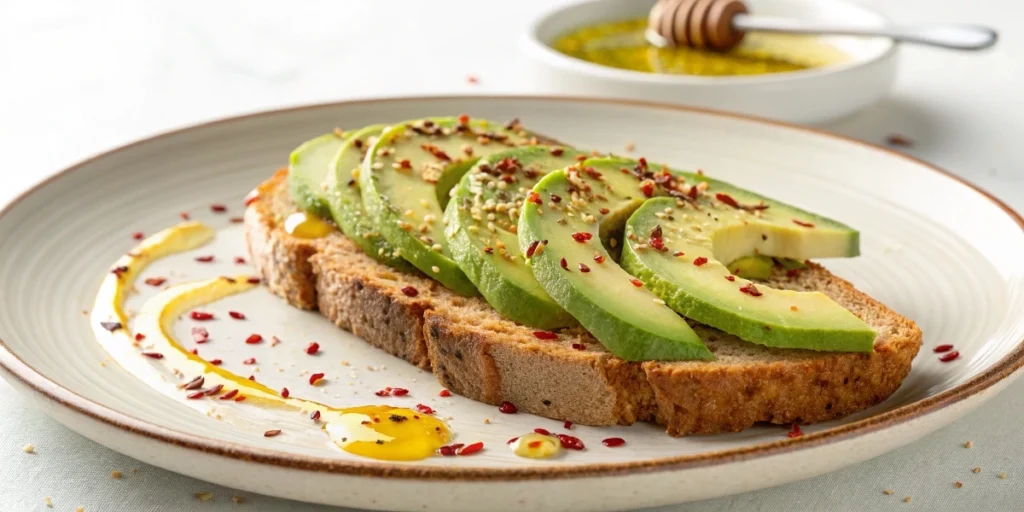
Frequently Asked Questions (FAQs)
Is buckwheat bread healthy?
Yes, buckwheat bread is a healthy choice. It’s rich in fiber, plant-based protein, and antioxidants like rutin and quercetin. Since it’s gluten-free and low on the glycemic index, it’s gentle on digestion and supports stable blood sugar levels. It also contains magnesium, iron, and B-vitamins that support heart and brain health.
Can buckwheat be used for bread?
Absolutely. Buckwheat flour is commonly used to make gluten-free bread, including sourdoughs, quick breads, and dense, rustic loaves. While it doesn’t contain gluten, it works well with binders like flaxseed or psyllium husk to create a moist and sliceable texture.
What are the pros and cons of buckwheat?
Pros:
- Gluten-free and allergy-friendly
- High in fiber and essential minerals
- Anti-inflammatory and heart-healthy
- Versatile in both sweet and savory recipes
Cons:
- Has a strong, earthy flavor some may not enjoy
- Doesn’t rise like wheat flour due to lack of gluten
- Needs binders when baking to avoid crumbling
Is buckwheat healthier than wheat?
Yes, in many ways. Buckwheat has a lower glycemic index, is naturally gluten-free, and contains more fiber, protein, and antioxidants than refined wheat. It’s also easier to digest and less processed, especially when made into homemade bread.
Is buckwheat bread anti-inflammatory?
Yes, buckwheat contains anti-inflammatory compounds, including flavonoids like rutin. It supports gut health, improves circulation, and may reduce symptoms of chronic inflammation. Many anti-inflammatory diets recommend buckwheat as a smart carbohydrate source.
Can I replace all-purpose flour with buckwheat flour?
You can, but it’s best to combine buckwheat flour with other gluten-free flours or use binders to maintain structure. A 1:1 substitution may work for dense loaves and quick breads, but for softer baked goods, blending buckwheat with tapioca, oat, or almond flour works better.
Conclusion
Whether you’re trying to eat cleaner, go gluten-free, or simply enjoy new flavors, buckwheat bread checks all the boxes. It’s rich in nutrients, incredibly versatile, and surprisingly easy to make at home. With a little creativity and the right baking approach, this earthy, hearty bread can be the foundation of your healthiest meals—from breakfast toast to dinner side.
Want more bread ideas? Don’t miss our cottage cheese banana bread for another delicious, wholesome option.
join us in
Print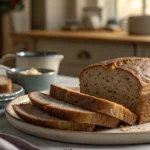
Buckwheat Bread: The Healthiest Grain-Free Bread You Need to Try
- Total Time: 1 hour 5 minutes
- Yield: 1 loaf (8–10 slices) 1x
Ingredients
2 cups buckwheat flour
1 tsp baking soda
1 tbsp apple cider vinegar
2 tbsp ground flaxseed (or chia seeds)
1 ½ cups warm water
2 tbsp olive oil (or coconut oil)
½ tsp sea salt
Optional: ¼ cup seeds, herbs, raisins, or dried fruit
Instructions
Preheat oven to 350°F (175°C) and line a loaf pan with parchment paper.
In a small bowl, mix flaxseed and 6 tbsp warm water. Let sit 5 mins to form a gel.
In a large bowl, combine buckwheat flour, baking soda, and sea salt.
Add flax gel, vinegar, oil, and remaining water to dry mix. Stir until well blended.
Fold in optional add-ins like sunflower seeds, chopped nuts, or dried fruit.
Pour batter into the loaf pan and smooth the top.
Bake for 50–60 minutes, or until a toothpick comes out clean.
Cool 10 minutes in pan, then remove and let cool fully on a wire rack.
Notes
Storage
Room Temp: 2–3 days (wrapped or in a bread box)
Refrigerator: Up to 7 days (sealed container)
Freezer: Up to 2 months (slice before freezing)
- Prep Time: 10 minutes
- Cook Time: 55 minutes
Nutrition
- Calories: 130 kcal
- Sugar: 1g
- Fat: 5g
- Carbohydrates: 18g
- Fiber: 2g
- Protein: 4g

